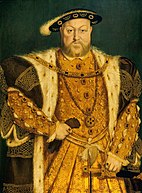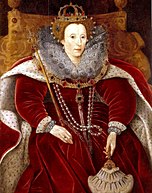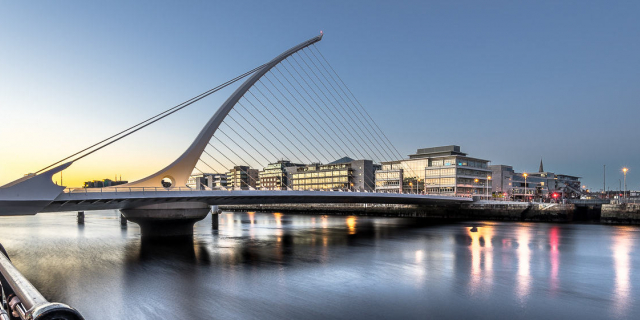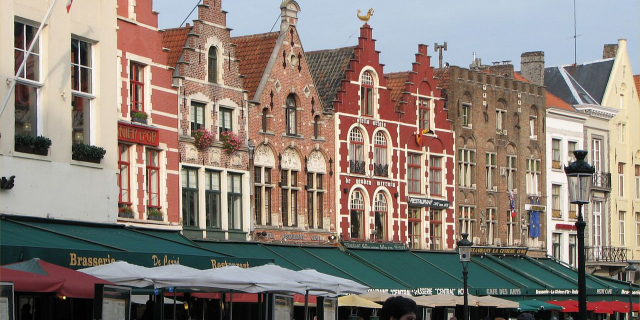England
Context of England
England is a country that is part of the United Kingdom. It shares land borders with Wales to its west and Scotland to its north. The Irish Sea lies northwest and the Celtic Sea area of the Atlantic Ocean to the southwest. It is separated from continental Europe by the North Sea to the east and the English Channel to the south. The country covers five-eighths of the island of Great Britain, which lies in the North Atlantic, and includes over 100 smaller islands, such as the Isles of Scilly and the Isle of Wight.
The area now called England was first inhabited by modern humans during the Upper Paleolithic period, but takes its name from the Angles, a Germanic tribe deriving its name from the Anglia peninsula, who settled during the 5th and 6th centuries. England became a unified state in the 10th century and has had a significant cultural and legal impact on the wider world since the Age of Discovery, which began during the 15th century....Read more
England is a country that is part of the United Kingdom. It shares land borders with Wales to its west and Scotland to its north. The Irish Sea lies northwest and the Celtic Sea area of the Atlantic Ocean to the southwest. It is separated from continental Europe by the North Sea to the east and the English Channel to the south. The country covers five-eighths of the island of Great Britain, which lies in the North Atlantic, and includes over 100 smaller islands, such as the Isles of Scilly and the Isle of Wight.
The area now called England was first inhabited by modern humans during the Upper Paleolithic period, but takes its name from the Angles, a Germanic tribe deriving its name from the Anglia peninsula, who settled during the 5th and 6th centuries. England became a unified state in the 10th century and has had a significant cultural and legal impact on the wider world since the Age of Discovery, which began during the 15th century.
The English language, the Anglican Church, and English law, which collectively served as the basis for the common law legal systems of many other countries around the world, developed in England, and the country's parliamentary system of government has been widely adopted by other nations. The Industrial Revolution began in 18th-century England, transforming its society into the world's first industrialised nation. England is also home to the two oldest institutions of higher learning in the English-speaking world, the University of Cambridge, founded in 1209, and the University of Oxford, founded in 1096, both of which are routinely ranked among the most prestigious universities globally.
England's terrain is chiefly low hills and plains, especially in the centre and south. Upland and mountainous terrain is mostly restricted to the north and west, including the Lake District, Pennines, Dartmoor and Shropshire Hills. The capital is London, whose greater metropolitan population of 14.2 million as of 2021 represents the United Kingdom's largest metropolitan area. England's population of 56.3 million comprises 84% of the population of the United Kingdom, largely concentrated around London, the South East, and conurbations in the Midlands, the North West, the North East, and Yorkshire, which each developed as major industrial regions during the 19th century.
The Kingdom of England, which after 1535 included Wales, ceased being a separate sovereign state on 1 May 1707, when the Acts of Union put into effect the terms agreed in the Treaty of Union the previous year, resulting in a political union with the Kingdom of Scotland to create the Kingdom of Great Britain. In 1801, Great Britain was united with the Kingdom of Ireland through another Act of Union to become the United Kingdom of Great Britain and Ireland. In 1922, the Irish Free State seceded from the United Kingdom, leading to the latter being renamed the United Kingdom of Great Britain and Northern Ireland.
More about England
- Native name England
- Calling code +44
- Population 46571900
- Area 130278
- Prehistory and antiquity
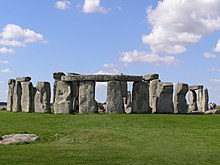 Stonehenge, a Neolithic monument
Stonehenge, a Neolithic monument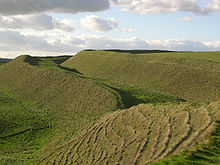 Read morePrehistory and antiquityRead less
Read morePrehistory and antiquityRead less Stonehenge, a Neolithic monument
Stonehenge, a Neolithic monument View of the ramparts of the developed hillfort of Maiden Castle, Dorset, as they look today
View of the ramparts of the developed hillfort of Maiden Castle, Dorset, as they look todayThe earliest known evidence of human presence in the area now known as England was that of Homo antecessor, dating to approximately 780,000 years ago. The oldest proto-human bones discovered in England date from 500,000 years ago.[1] Modern humans are known to have inhabited the area during the Upper Paleolithic period, though permanent settlements were only established within the last 6,000 years.[2] After the last ice age only large mammals such as mammoths, bison and woolly rhinoceros remained. Roughly 11,000 years ago, when the ice sheets began to recede, humans repopulated the area; genetic research suggests they came from the northern part of the Iberian Peninsula.[3] The sea level was lower than the present day and Britain was connected by land bridge to Ireland and Eurasia.[4] As the seas rose, it was separated from Ireland 10,000 years ago and from Eurasia two millennia later.
The Beaker culture arrived around 2,500 BC, introducing drinking and food vessels constructed from clay, as well as vessels used as reduction pots to smelt copper ores.[5] It was during this time that major Neolithic monuments such as Stonehenge and Avebury were constructed. By heating together tin and copper, which were in abundance in the area, the Beaker culture people made bronze, and later iron from iron ores. The development of iron smelting allowed the construction of better ploughs, advancing agriculture (for instance, with Celtic fields), as well as the production of more effective weapons.[6]
During the Iron Age, Celtic culture, deriving from the Hallstatt and La Tène cultures, arrived from Central Europe. Brythonic was the spoken language during this time. Society was tribal; according to Ptolemy's Geographia there were around 20 tribes in the area. Earlier divisions are unknown because the Britons were not literate. Like other regions on the edge of the Empire, Britain had long enjoyed trading links with the Romans. Julius Caesar of the Roman Republic attempted to invade twice in 55 BC; although largely unsuccessful, he managed to set up a client king from the Trinovantes.
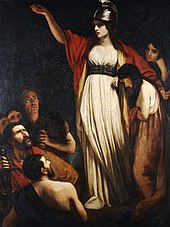 Boudica led an uprising against the Roman Empire.
Boudica led an uprising against the Roman Empire.The Romans invaded Britain in 43 AD during the reign of Emperor Claudius, subsequently conquering much of Britain, and the area was incorporated into the Roman Empire as Britannia province.[7] The best-known of the native tribes who attempted to resist were the Catuvellauni led by Caratacus. Later, an uprising led by Boudica, Queen of the Iceni, ended with Boudica's suicide following her defeat at the Battle of Watling Street.[8] The author of one study of Roman Britain suggested that from 43 AD to 84 AD, the Roman invaders killed somewhere between 100,000 and 250,000 people from a population of perhaps 2,000,000.[9] This era saw a Greco-Roman culture prevail with the introduction of Roman law, Roman architecture, aqueducts, sewers, many agricultural items and silk.[10] In the 3rd century, Emperor Septimius Severus died at Eboracum (now York), where Constantine was subsequently proclaimed emperor a century later.[11]
There is debate about when Christianity was first introduced; it was no later than the 4th century, probably much earlier. According to Bede, missionaries were sent from Rome by Eleutherius at the request of the chieftain Lucius of Britain in 180 AD, to settle differences as to Eastern and Western ceremonials, which were disturbing the church. There are traditions linked to Glastonbury claiming an introduction through Joseph of Arimathea, while others claim through Lucius of Britain.[12] By 410, during the decline of the Roman Empire, Britain was left exposed by the end of Roman rule in Britain and the withdrawal of Roman army units, to defend the frontiers in continental Europe and partake in civil wars.[13] Celtic Christian monastic and missionary movements flourished: Patrick (5th-century Ireland) and in the 6th century Brendan (Clonfert), Comgall (Bangor), David (Wales), Aiden (Lindisfarne) and Columba (Iona). This period of Christianity was influenced by ancient Celtic culture in its sensibilities, polity, practices and theology. Local "congregations" were centred in the monastic community and monastic leaders were more like chieftains, as peers, rather than in the more hierarchical system of the Roman-dominated church.[14]
Middle Ages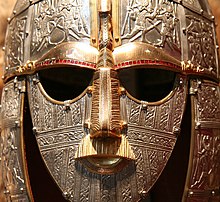 Replica of the 7th-century ceremonial Sutton Hoo helmet from the Kingdom of East Anglia
Replica of the 7th-century ceremonial Sutton Hoo helmet from the Kingdom of East AngliaRoman military withdrawals left Britain open to invasion by pagan, seafaring warriors from north-western continental Europe, chiefly the Saxons, Angles, Jutes and Frisians who had long raided the coasts of the Roman province. These groups then began to settle in increasing numbers over the course of the fifth and sixth centuries, initially in the eastern part of the country.[13] Their advance was contained for some decades after the Britons' victory at the Battle of Mount Badon, but subsequently resumed, overrunning the fertile lowlands of Britain and reducing the area under Brittonic control to a series of separate enclaves in the more rugged country to the west by the end of the 6th century. Contemporary texts describing this period are extremely scarce, giving rise to its description as a Dark Age. The nature and progression of the Anglo-Saxon settlement of Britain is consequently subject to considerable disagreement; the emerging consensus is that it occurred on a large scale in the south and east but was less substantial to the north and west, where Celtic languages continued to be spoken even in areas under Anglo-Saxon control.[15][16] Roman-dominated Christianity had, in general, been replaced in the conquered territories by Anglo-Saxon paganism, but was reintroduced by missionaries from Rome led by Augustine from 597 onwards.[17] Disputes between the Roman- and Celtic-dominated forms of Christianity ended in victory for the Roman tradition at the Council of Whitby (664), which was ostensibly about tonsures (clerical haircuts) and the date of Easter, but more significantly, about the differences in Roman and Celtic forms of authority, theology, and practice.[14]
During the settlement period the lands ruled by the incomers seem to have been fragmented into numerous tribal territories, but by the 7th century, when substantial evidence of the situation again becomes available, these had coalesced into roughly a dozen kingdoms including Northumbria, Mercia, Wessex, East Anglia, Essex, Kent and Sussex. Over the following centuries, this process of political consolidation continued.[18] The 7th century saw a struggle for hegemony between Northumbria and Mercia, which in the 8th century gave way to Mercian preeminence.[19] In the early 9th century Mercia was displaced as the foremost kingdom by Wessex. Later in that century escalating attacks by the Danes culminated in the conquest of the north and east of England, overthrowing the kingdoms of Northumbria, Mercia and East Anglia. Wessex under Alfred the Great was left as the only surviving English kingdom, and under his successors, it steadily expanded at the expense of the kingdoms of the Danelaw. This brought about the political unification of England, first accomplished under Æthelstan in 927 and definitively established after further conflicts by Eadred in 953. A fresh wave of Scandinavian attacks from the late 10th century ended with the conquest of this united kingdom by Sweyn Forkbeard in 1013 and again by his son Cnut in 1016, turning it into the centre of a short-lived North Sea Empire that also included Denmark and Norway. However, the native royal dynasty was restored with the accession of Edward the Confessor in 1042.
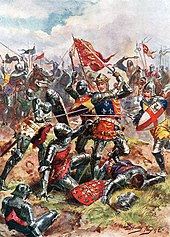 King Henry V at the Battle of Agincourt, fought on Saint Crispin's Day and concluded with an English victory against a larger French army in the Hundred Years' War
King Henry V at the Battle of Agincourt, fought on Saint Crispin's Day and concluded with an English victory against a larger French army in the Hundred Years' WarA dispute over the succession to Edward led to the Norman Conquest in 1066, accomplished by an army led by Duke William of Normandy.[20] The Normans themselves originated from Scandinavia and had settled in Normandy in the late 9th and early 10th centuries.[21] This conquest led to the almost total dispossession of the English elite and its replacement by a new French-speaking aristocracy, whose speech had a profound and permanent effect on the English language.[22]
Subsequently, the House of Plantagenet from Anjou inherited the English throne under Henry II, adding England to the budding Angevin Empire of fiefs the family had inherited in France including Aquitaine.[23] They reigned for three centuries, some noted monarchs being Richard I, Edward I, Edward III and Henry V.[23] The period saw changes in trade and legislation, including the signing of the Magna Carta, an English legal charter used to limit the sovereign's powers by law and protect the privileges of freemen. Catholic monasticism flourished, providing philosophers, and the universities of Oxford and Cambridge were founded with royal patronage. The Principality of Wales became a Plantagenet fief during the 13th century[24] and the Lordship of Ireland was given to the English monarchy by the Pope.
During the 14th century, the Plantagenets and the House of Valois both claimed to be legitimate claimants to the House of Capet and with it France; the two powers clashed in the Hundred Years' War.[25] The Black Death epidemic hit England; starting in 1348, it eventually killed up to half of England's inhabitants.[26] From 1453 to 1487 civil war occurred between two branches of the royal family – the Yorkists and Lancastrians – known as the Wars of the Roses.[27] Eventually it led to the Yorkists losing the throne entirely to a Welsh noble family the Tudors, a branch of the Lancastrians headed by Henry Tudor who invaded with Welsh and Breton mercenaries, gaining victory at the Battle of Bosworth Field where the Yorkist king Richard III was killed.[28]
Early modernKing Henry VIII (1491–1547)Queen Elizabeth I (1558–1603)During the Tudor period, the Renaissance reached England through Italian courtiers, who reintroduced artistic, educational and scholarly debate from classical antiquity.[29] England began to develop naval skills, and exploration to the West intensified.[30] Henry VIII broke from communion with the Catholic Church, over issues relating to his divorce, under the Acts of Supremacy in 1534 which proclaimed the monarch head of the Church of England. In contrast with much of European Protestantism, the roots of the split were more political than theological.[a] He also legally incorporated his ancestral land Wales into the Kingdom of England with the 1535–1542 acts. There were internal religious conflicts during the reigns of Henry's daughters, Mary I and Elizabeth I. The former took the country back to Catholicism while the latter broke from it again, forcefully asserting the supremacy of Anglicanism. The Elizabethan era is the epoch in the Tudor age of the reign of Queen Elizabeth I ("the Virgin Queen"). Historians often depict it as the golden age in English history. Elizabethan England represented the apogee of the English Renaissance and saw the flowering of art, poetry, music and literature.[32] The era is most famous for its drama, theatre and playwrights. England during this period had a centralised, well-organised, and effective government as a result of vast Tudor reforms.[33]
Competing with Spain, the first English colony in the Americas was founded in 1585 by explorer Walter Raleigh in Virginia and named Roanoke. The Roanoke colony failed and is known as the lost colony after it was found abandoned on the return of the late-arriving supply ship.[34] With the East India Company, England also competed with the Dutch and French in the East. During the Elizabethan period, England was at war with Spain. An armada sailed from Spain in 1588 as part of a wider plan to invade England and re-establish a Catholic monarchy. The plan was thwarted by bad coordination, stormy weather and successful harrying attacks by an English fleet under Lord Howard of Effingham. This failure did not end the threat: Spain launched two further armadas, in 1596 and 1597, but both were driven back by storms.
Union with ScotlandThe political structure of the island changed in 1603, when the King of Scots, James VI, a kingdom which had been a long-time rival to English interests, inherited the throne of England as James I, thereby creating a personal union.[35] He styled himself King of Great Britain, although this had no basis in English law.[36] Under the auspices of James VI and I the Authorised King James Version of the Holy Bible was published in 1611. It was the standard version of the Bible read by most Protestant Christians for four hundred years until modern revisions were produced in the 20th century.
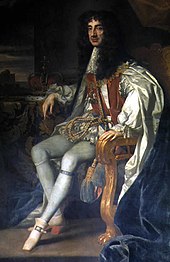 The English Restoration restored the monarchy under King Charles II and peace after the English Civil War.
The English Restoration restored the monarchy under King Charles II and peace after the English Civil War.Based on conflicting political, religious and social positions, the English Civil War was fought between the supporters of Parliament and those of King Charles I, known colloquially as Roundheads and Cavaliers respectively. This was an interwoven part of the wider multifaceted Wars of the Three Kingdoms, involving Scotland and Ireland. The Parliamentarians were victorious, Charles I was executed and the kingdom replaced by the Commonwealth. Leader of the Parliament forces, Oliver Cromwell declared himself Lord Protector in 1653; a period of personal rule followed.[37] After Cromwell's death and the resignation of his son Richard as Lord Protector, Charles II was invited to return as monarch in 1660, in a move called the Restoration. With the reopening of theatres, fine arts, literature and performing arts flourished throughout the Restoration of ''the Merry Monarch'' Charles II.[38] After the Glorious Revolution of 1688, it was constitutionally established that King and Parliament should rule together, though Parliament would have the real power. This was established with the Bill of Rights in 1689. Among the statutes set down were that the law could only be made by Parliament and could not be suspended by the King, also that the King could not impose taxes or raise an army without the prior approval of Parliament.[39] Also since that time, no British monarch has entered the House of Commons when it is sitting, which is annually commemorated at the State Opening of Parliament by the British monarch when the doors of the House of Commons are slammed in the face of the monarch's messenger, symbolising the rights of Parliament and its independence from the monarch.[40] With the founding of the Royal Society in 1660, science was greatly encouraged.
In 1666, the Great Fire of London gutted the City of London but it was rebuilt shortly afterwards[41] with many significant buildings designed by Christopher Wren. In Parliament two factions had emerged – the Tories and Whigs. Though the Tories initially supported Catholic king James II, some of them, along with the Whigs, during the Revolution of 1688 invited Dutch Prince William of Orange to defeat James and ultimately to become William III of England. Some English people, especially in the north, were Jacobites and continued to support James and his sons. Under the Stuart dynasty England expanded in trade, finance and prosperity. Britain developed Europe's largest merchant fleet.[42] After the parliaments of England and Scotland agreed,[43] the two countries joined in political union, to create the Kingdom of Great Britain in 1707.[35] To accommodate the union, institutions such as the law and national churches of each remained separate.[44]
Late modern and contemporary The River Thames during the Georgian period from the Terrace of Somerset House looking towards St. Paul's, c. 1750
The River Thames during the Georgian period from the Terrace of Somerset House looking towards St. Paul's, c. 1750Under the newly formed Kingdom of Great Britain, output from the Royal Society and other English initiatives combined with the Scottish Enlightenment to create innovations in science and engineering, while the enormous growth in British overseas trade protected by the Royal Navy paved the way for the establishment of the British Empire. Domestically it drove the Industrial Revolution, a period of profound change in the socioeconomic and cultural conditions of England, resulting in industrialised agriculture, manufacture, engineering and mining, as well as new and pioneering road, rail and water networks to facilitate their expansion and development.[45] The opening of Northwest England's Bridgewater Canal in 1761 ushered in the canal age in Britain.[46] In 1825 the world's first permanent steam locomotive-hauled passenger railway – the Stockton and Darlington Railway – opened to the public.[46]
 The Battle of Trafalgar was a naval engagement between the British Royal Navy and the combined fleets of the French and Spanish Navies during the Napoleonic Wars.[47]
The Battle of Trafalgar was a naval engagement between the British Royal Navy and the combined fleets of the French and Spanish Navies during the Napoleonic Wars.[47]During the Industrial Revolution, many workers moved from England's countryside to new and expanding urban industrial areas to work in factories, for instance at Birmingham and Manchester, dubbed "Workshop of the World" and "Warehouse City" respectively.[48] Manchester was the world's first industrial city.[49] England maintained relative stability throughout the French Revolution; William Pitt the Younger was British prime minister for the reign of George III. The Regency of George IV is noted for its elegance and achievements in the fine arts and architecture.[50] During the Napoleonic Wars, Napoleon planned to invade from the south-east. However, this failed to manifest and the Napoleonic forces were defeated by the British: at sea by Horatio Nelson, and on land by Arthur Wellesley. The major victory at the Battle of Trafalgar confirmed the naval supremacy Britain had established during the course of the eighteenth century.[51] The Napoleonic Wars fostered a concept of Britishness and a united national British people, shared with the English, Scots and Welsh.[52]
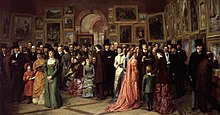 The Victorian era is often cited as a Golden Age. Painting done by William Powell Frith to show cultural divisions.
The Victorian era is often cited as a Golden Age. Painting done by William Powell Frith to show cultural divisions.London became the largest and most populous metropolitan area in the world during the Victorian era, and trade within the British Empire – as well as the standing of the British military and navy – was prestigious.[53] Technologically, this era saw many innovations that proved key to the United Kingdom's power and prosperity.[54] Political agitation at home from radicals such as the Chartists and the suffragettes enabled legislative reform and universal suffrage.[55] Samuel Hynes described the Edwardian era as a "leisurely time when women wore picture hats and did not vote, when the rich were not ashamed to live conspicuously, and the sun really never set on the British flag."[56]
Power shifts in east-central Europe led to World War I; hundreds of thousands of English soldiers died fighting for the United Kingdom as part of the Allies.[b] Two decades later, in World War II, the United Kingdom was again one of the Allies. At the end of the Phoney War, Winston Churchill became the wartime prime minister. Developments in warfare technology saw many cities damaged by air-raids during the Blitz. Following the war, the British Empire experienced rapid decolonisation, and there was a speeding-up of technological innovations; automobiles became the primary means of transport and Frank Whittle's development of the jet engine led to wider air travel.[58] Residential patterns were altered in England by private motoring, and by the creation of the National Health Service (NHS) in 1948. The UK's NHS provided publicly funded health care to all UK permanent residents free at the point of need, being paid for from general taxation. Combined, these prompted the reform of local government in England in the mid-20th century.[59]
Since the 20th century, there has been significant population movement to England, mostly from other parts of the British Isles, but also from the Commonwealth, particularly the Indian subcontinent.[60] Since the 1970s there has been a large move away from manufacturing and an increasing emphasis on the service industry.[61] As part of the United Kingdom, the area joined a common market initiative called the European Economic Community which became the European Union. Since the late 20th century the administration of the United Kingdom has moved towards devolved governance in Scotland, Wales and Northern Ireland.[62] England and Wales continues to exist as a jurisdiction within the United Kingdom.[63] Devolution has stimulated a greater emphasis on a more English-specific identity and patriotism.[64] There is no devolved English government, but an attempt to create a similar system on a sub-regional basis was rejected by referendum.[65]
^ "500,000 BC – Boxgrove". Current Archaeology. Current Publishing. 24 May 2007. Retrieved 20 December 2010. ^ "Palaeolithic Archaeology Teaching Resource Box" (PDF). Palaeolithic Rivers of South-West Britain Project(2006). Archived from the original (PDF) on 5 May 2021. Retrieved 20 December 2010.; "Chalk east". A Geo East Project. Archived from the original on 5 March 2011. Retrieved 20 December 2010. ^ Oppenheimer 2006, p. 173. ^ "Tertiary Rivers: Tectonic and structural background". University of Cambridge. Retrieved 9 September 2009. ^ "Function and significance of Bell Beaker pottery according to data from residue analyses". Retrieved 21 December 2010. ^ Reid, Struan (1994). Inventions and Trade. P.8. ISBN 978-0-921921-30-1. Retrieved 23 December 2010. ^ Burke, Jason (2 December 2000). "Dig uncovers Boudicca's brutal streak". The Observer. London. Archived from the original on 22 October 2003. Retrieved 5 September 2009. ^ "Cornelius Tacitus, The Annals". Alfred John Church, William Jackson Brudribh, Ed. Retrieved 22 December 2010. ^ Goldsworthy, Adrian (2016). Pax Romana: War, Peace and Conquest in the Roman World. Hachette UK. p. 276. ^ Bedoyere, Guy. "Architecture in Roman Britain". Heritage Key. Archived from the original on 3 July 2009. Retrieved 23 December 2010.; Philip, Robert (1860). The History of Progress in Great Britain. Vol. 2. Retrieved 23 December 2010.; Rees, Bob; Shute, Paul; Kelly, Nigel (9 January 2003). Medicine through time. Heinemann. ISBN 978-0-435-30841-4. Retrieved 24 December 2010. ^ Rankov 1994, p. 16. ^ Wright 2008, p. 143. ^ a b James, Edward. "Overview: Anglo-Saxons, 410 to 800". BBC. Retrieved 3 December 2010. ^ a b Lehane, Brendan (1968). Early Christian Christianity. John Murray. ^ Dark, Ken R. (2003). "Large-scale population movements into and from Britain south of Hadrian's Wall in the fourth to sixth centuries AD" (PDF). Archived from the original (PDF) on 1 June 2021. Retrieved 20 June 2020.; Martin, Toby F. (2015). The Cruciform Brooch and Anglo-Saxon England. Boydell and Brewer Press. pp. 174–178.; Coates, Richard. "Celtic whispers: revisiting the problems of the relation between Brittonic and Old English".; Kortlandt, Frederik (2018). "Relative Chronology" (PDF).; Fox, Bethany. "The P-Celtic Place Names of North-East England and South-East Scotland". ^ Härke, Heinrich (2011). "Anglo-Saxon Immigration and Ethnogenesis". Medieval Archaeology. 55 (1): 1–28. doi:10.1179/174581711X13103897378311. S2CID 162331501. ^ "The Christian Tradition". PicturesofEngland.com. Retrieved 5 September 2009. ^ Kirby 2000, p. 4. ^ Lyon 1960, p. 23. ^ "Overview: The Normans, 1066–1154". BBC. Retrieved 3 December 2010. ^ Crouch 2006, pp. 2–4 ^ "Norman invasion word impact study". BBC News. 20 February 2008. Retrieved 3 December 2010. ^ a b Bartlett 1999, p. 124. ^ "Edward I (r. 1272–1307)". Royal.gov.uk. Archived from the original on 24 June 2008. Retrieved 21 September 2009. ^ Fowler 1967, p. 208. ^ Ziegler 2003, p. 230; Goldberg 1996, p. 4. ^ Crofton 2007, p. 111. ^ "Richard III (r. 1483–1485)". Royal.gov.uk. Archived from the original on 10 July 2008. Retrieved 21 September 2009. ^ Hay, Denys (1988). Renaissance essays. p. 65. ISBN 978-0-907628-96-5. Retrieved 26 December 2010. ^ "Royal Navy History, Tudor Period and the Birth of a Regular Navy". Archived from the original on 18 January 2012. Retrieved 24 December 2010.; Smith, Goldwin. England Under the Tudors. p. 176. ISBN 978-1-60620-939-4. Retrieved 26 December 2010. ^ Scruton 1982, p. 470. ^ From the 1944 Clark lectures by C. S. Lewis; Lewis, English Literature in the Sixteenth Century (Oxford, 1954) p. 1, OCLC 256072 ^ "Tudor Parliaments". Spartacus Educational. Retrieved 4 April 2021. ^ Ordahl, Karen (25 February 2007). Roanak:the abandoned colony. Rowman & Littlefield publishers Inc. ISBN 978-0-7425-5263-0. Retrieved 24 December 2010. ^ a b Colley 1992, p. 12.; "Making the Act of Union". Parliament.uk. Archived from the original on 9 June 2008. Retrieved 5 September 2009. ^ Hay, Denys. "The term "Great Britain" in the Middle Ages" (PDF). ads.ahds.ac.uk. Archived from the original (PDF) on 25 March 2009. Retrieved 19 February 2009. ^ "Oliver Cromwell (English statesman)". Encyclopædia Britannica. britannica.com. 2009. Retrieved 8 August 2009. ^ Lyndsey Bakewell, "Changing scenes and flying machines: re-examination of spectacle and the spectacular in Restoration theatre, 1660–1714" (PhD. Diss. Loughborough University, 2016) online. ^ Adler, Philip J.; Pouwels, Randall L. (27 November 2007). World Civilization. p. 340. ISBN 978-0-495-50262-3. Retrieved 24 December 2010. ^ "Democracy Live: Black Rod". BBC. Retrieved 6 August 2008; Chisholm, Hugh, ed. (1911). . Encyclopædia Britannica. Vol. 4 (11th ed.). Cambridge University Press. ^ "London's Burning: The Great Fire". BBC News. Retrieved 25 September 2009. ^ "The History Press | The Stuarts". www.thehistorypress.co.uk. Retrieved 11 April 2021. ^ Cite error: The named reference unionwithscotland was invoked but never defined (see the help page). ^ Gallagher 2006, p. 14. ^ Hudson, Pat. "The Workshop of the World". BBC. Retrieved 10 December 2010. ^ a b Office for National Statistics 2000, p. 5; McNeil & Nevell 2000, p. 4. ^ "Department of History – Napoleonic Wars". 28 July 2014. Archived from the original on 28 July 2014. Retrieved 8 April 2021. ^ McNeil & Nevell 2000, p. 9.; Birmingham City Council. "Heritage". visitbirmingham.com. Archived from the original on 26 April 2012. Retrieved 4 October 2009. ^ "Manchester – the first industrial city". Entry on Sciencemuseum website. Archived from the original on 9 March 2012. Retrieved 17 March 2012. ^ "Regency | British Architectural Dates and Styles | Property | UK | Mayfair Office". www.mayfairoffice.co.uk. Retrieved 8 April 2021. ^ Bennet, Geoffrey (2004). The Battle of Trafalgar. England: Pen & Sword Books Limited, CPI UK, South Yorkshire. ^ Colley 1992, p. 1. ^ Haggard, Robert F. (2001). The persistence of Victorian liberalism:The Politics of Social Reform in Britain, 1870–1900. p. 13. ISBN 978-0-313-31305-9. Retrieved 26 December 2010. ^ Atterbury, Paul (17 February 2011). "Victorian Technology". BBC History. Retrieved 13 October 2020. ^ Crawford, Elizabeth. "Women: From Abolition to the Vote". BBC. Retrieved 10 December 2010. ^ "Manor House. Edwardian Life | PBS". www.pbs.org. ^ Cox 1970, p. 180. ^ Golley, John (10 August 1996). "Obituaries: Air Commodore Sir Frank Whittle". The Independent. London. Retrieved 2 December 2010. ^ Clark, Steed & Marshall 1973, p. 1; Wilson & Game 2002, p. 55. ^ Gallagher 2006, pp. 10–11. ^ Cite error: The named reference thatcher was invoked but never defined (see the help page). ^ Keating, Michael (1 January 1998). "Reforging the Union: Devolution and Constitutional Change in the United Kingdom". Publius: The Journal of Federalism. 28 (1): 217. doi:10.1093/oxfordjournals.pubjof.a029948. ^ "The coming of the Tudors and the Act of Union". BBC Wales. BBC News. 2009. Retrieved 9 September 2009. ^ Kenny, English & Hayton 2008, p. 3; Ward 2004, p. 180. ^ Cite error: The named reference refreject was invoked but never defined (see the help page).
Cite error: There are <ref group=lower-alpha> tags or {{efn}} templates on this page, but the references will not show without a {{reflist|group=lower-alpha}} template or {{notelist}} template (see the help page).
- Stay safe
In any emergency call 999 or 112 and ask for "ambulance", "fire", "police" or "coast guard" when connected. If you need more than one service that includes an ambulance (e.g. a road collision) then ask for an ambulance and they will contact the relevant services themselves.
If you need to contact the police when an emergency response is not needed, call the 101 police non-emergency number (e.g. property or car has been damaged or stolen or to give the police information about crime or a general enquiry.
England by and large is a safe place to live and visit; violent crime against tourists is rare, but you should always use general common sense to ensure you keep out of trouble. In most of the major cities, you will find outlying suburban and inner city areas where poverty, crime and gang violence are common. These areas can be quite risky (by western standards) and should be avoided. Again, common sense is the best way to stay safe, and a visitor would be very unlikely to end up in such areas anyway. In a situation where you feel uncomfortable out on the street (for example, if a gang of youths block your path and are behaving in a rowdy manner), it's usually fine to cross the road and walk past and not to respond to them as they are not generally interested in harassing people as they may appear and will ignore you in most cases.
Crime rates are generally very low in rural areas, although some small poorer towns can be surprisingly rough. Having said that, caution is advisable when travelling alone in remote areas. You should always try to tell somebody you trust where you're going; even if they are not in England themselves, they can alert the UK police if you encounter problems.
Take care when driving on country lanes as they can become very narrow and the lesser travelled ones are often in poor condition. Country lanes may also feature tight corners with relatively little visibility, and may at times become essentially one-way roads. These roads mostly do not have street lights, and are typically not gritted in winter, so be careful at night and in snowy or icy conditions. If you are driving along a country lane and break down, it may take some considerable time for rescue vehicles to reach you.
It is worth taking care on some public transport at night, as rowdy drunks can be a problem. Also, in some cities, there have been incidents of street gangs carrying out robberies on buses and trains at night. Visitors should not be too concerned, however, as these are very rare occurrences.
...Read moreStay safeRead lessIn any emergency call 999 or 112 and ask for "ambulance", "fire", "police" or "coast guard" when connected. If you need more than one service that includes an ambulance (e.g. a road collision) then ask for an ambulance and they will contact the relevant services themselves.
If you need to contact the police when an emergency response is not needed, call the 101 police non-emergency number (e.g. property or car has been damaged or stolen or to give the police information about crime or a general enquiry.
England by and large is a safe place to live and visit; violent crime against tourists is rare, but you should always use general common sense to ensure you keep out of trouble. In most of the major cities, you will find outlying suburban and inner city areas where poverty, crime and gang violence are common. These areas can be quite risky (by western standards) and should be avoided. Again, common sense is the best way to stay safe, and a visitor would be very unlikely to end up in such areas anyway. In a situation where you feel uncomfortable out on the street (for example, if a gang of youths block your path and are behaving in a rowdy manner), it's usually fine to cross the road and walk past and not to respond to them as they are not generally interested in harassing people as they may appear and will ignore you in most cases.
Crime rates are generally very low in rural areas, although some small poorer towns can be surprisingly rough. Having said that, caution is advisable when travelling alone in remote areas. You should always try to tell somebody you trust where you're going; even if they are not in England themselves, they can alert the UK police if you encounter problems.
Take care when driving on country lanes as they can become very narrow and the lesser travelled ones are often in poor condition. Country lanes may also feature tight corners with relatively little visibility, and may at times become essentially one-way roads. These roads mostly do not have street lights, and are typically not gritted in winter, so be careful at night and in snowy or icy conditions. If you are driving along a country lane and break down, it may take some considerable time for rescue vehicles to reach you.
It is worth taking care on some public transport at night, as rowdy drunks can be a problem. Also, in some cities, there have been incidents of street gangs carrying out robberies on buses and trains at night. Visitors should not be too concerned, however, as these are very rare occurrences.
Some town and city centres should be approached with caution during the later evening on Fridays and Saturdays in particular, as high levels of drunkenness can be rife. Some English people become aggressive when drunk, and outbreaks of unprovoked violence have happened. Common sense can help avoid problems with drunken people. Many drunk people will simply be loud and unconcerned with tourists. At night it is also recommended that you use licensed taxis or licensed mini cabs. Taxis are available at taxi ranks or by phone, while mini cabs are by phone booking only—asking at the bar will usually provide you with numbers. Unofficial/unlicensed mini cabs that cruise the street looking for fares have a reputation as dangerous for lone females (and in rare instances, males); the most common incident is the passenger is driven to a secluded area, and then raped. In any case, it is completely within the passenger's rights to ask to see a taxi driver's licence and to turn down the service if he or she cannot show it.
Take care on matchdays in football and rugby, particularly for teams known for their rivalry, or teams from the same town or city facing one another, known as a derby day. Some derbies like Liverpool VS Man United or the Manchester derby can get violent if you wear the wrong team's kit in the wrong place, or if you mock the opposing team. Although hooliganism has died down in many places, if you use common sense you will be safe. Because of serious rivalry with some sporting teams, many pubs and bars ban wearing football or rugby shirts.






